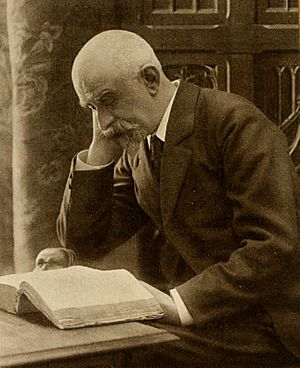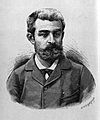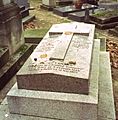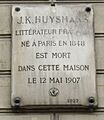Joris-Karl Huysmans facts for kids
Quick facts for kids
Joris–Karl Huysmans
|
|
|---|---|
 |
|
| Born | Charles-Marie-Georges Huysmans 5 February 1848 Paris, France |
| Died | 12 May 1907 (aged 59) Paris, France |
| Occupation | Novelist |
| Genre | Fiction |
| Literary movement | Decadent |
| Notable works | À rebours (1884), Là-bas (1891), En route (1895), La cathédrale (1898) |
| Signature | |
 |
|
Charles-Marie-Georges Huysmans (born February 5, 1848 – died May 12, 1907) was a French novelist and art critic. He wrote his books using the name Joris-Karl Huysmans. He is most famous for his novel À rebours (1884), which is known in English as Against the Grain or Against Nature. For 30 years, he worked for the French government to support himself.
Huysmans's writing is special because of his unique way of using the French language. He had a very large vocabulary and wrote detailed descriptions. His work also showed a clever, funny, and sometimes sarcastic style, along with a wide range of knowledge. At first, his writing was seen as part of a style called Naturalism. But after he published À rebours, he became known for the decadent movement. His books often showed his deep pessimism, which is a belief that things will always turn out badly. This led him to follow the ideas of a philosopher named Arthur Schopenhauer. Later in his life, his novels showed his interest in Catholicism. They also explored his own religious conversion and his decision to become an oblate, which is someone who dedicates their life to God, often living near a monastery. In his book La cathédrale (1898), he wrote a lot about the symbols and art found in Christian architecture, especially focusing on Chartres Cathedral.
His novels Là-bas (1891), En route (1895), and La cathédrale (1898) form a series. These books follow a character named Durtal on a spiritual journey as he slowly becomes a Catholic. In the next novel, L'Oblat (1903), Durtal becomes an oblate in a monastery, just like Huysmans himself did at the Benedictine Abbey in Ligugé in 1901. La cathédrale was his most successful book, earning him enough money to leave his government job and live from his book sales.
Contents
Early Life and Family
Joris-Karl Huysmans was born in Paris in 1848. His father, Godfried Huysmans, was Dutch and worked as a lithographer, making prints. His mother, Malvina Badin Huysmans, used to be a schoolteacher. Huysmans's father died when he was only eight years old. Soon after, his mother remarried. Huysmans did not get along with his stepfather, Jules Og, who was a Protestant and part-owner of a book-binding business in Paris.
As a child, Huysmans stopped following the Roman Catholic Church. He was not happy at school, but he finished his studies and earned his baccalauréat, which is a French high school diploma.
Working for the Government
For 32 years, Huysmans worked for the French Ministry of the Interior, which is a government department. He found this job very boring. When he was young, Huysmans was called to fight in the Franco-Prussian War. However, he became sick with dysentery and was sent home from the army. He later used this experience in an early story called "Sac au dos" (Backpack).
After he retired from his government job in 1898, thanks to the success of his novel La cathédrale, Huysmans planned to leave Paris. He wanted to move to Ligugé and create a community for Catholic artists. One artist he admired was Charles-Marie Dulac. However, Dulac died a few months before Huysmans could move, so Huysmans decided to stay in Paris.
Besides his novels, Huysmans was also known for writing about art. His art reviews appeared in books like L'Art moderne (1883) and Certains (1889). He was also one of the first members of the Académie Goncourt, a famous French literary group. He was an early supporter of Impressionism, a style of painting, and admired artists like Gustave Moreau and Odilon Redon.
In 1905, doctors found that Huysmans had cancer of the mouth. He died in 1907 and was buried in the Montparnasse Cemetery in Paris.
Personal Life
Joris-Karl Huysmans never got married or had children. He had a long, on-and-off relationship with a seamstress named Anna Meunier.
His Writing Journey
When he published his books, Joris-Karl Huysmans used that name to honor his father's family background. His first important book was a collection of prose poems called Le drageoir aux épices (1874). These poems were greatly influenced by the writer Baudelaire. They did not get much attention, but they showed hints of Huysmans's unique writing style.
After that, Huysmans wrote the novel Marthe, Histoire d'une fille (1876). His next books were similar: serious, realistic, and full of detailed descriptions of Paris, a city he knew very well. Les Soeurs Vatard (1879), which he dedicated to the famous writer Zola, tells the story of women working in a bookbinding shop. En ménage (1881) is about a writer's marriage that fails. The most important work from his early period is the short novel À vau-l'eau (1882), also known as Downstream. It tells the story of a struggling office worker, Monsieur Folantin, who is just trying to find a good meal.
Huysmans's novel À rebours (1884), meaning Against the Grain or Against Nature, became his most famous book. It tells the story of a character named des Esseintes, who is an aesthete, someone who loves beauty and art. This book was a clear break from the Naturalism style. It was seen as an example of "decadent" literature, which focused on artificiality and unusual experiences.
Huysmans slowly moved away from the Naturalist writers and found new friends among the Symbolist and Catholic writers. He had praised their work in À rebours. These friends included Jules Barbey d'Aurevilly, Villiers de L'Isle Adam, and Léon Bloy. The poet Stéphane Mallarmé was so happy that his poems were mentioned in the novel that he dedicated one of his most famous poems, "Prose pour des Esseintes," to the book's main character. A writer named Barbey d'Aurevilly told Huysmans that after writing À rebours, he would have to choose between "the muzzle of a pistol and the foot of the Cross." Huysmans, who had a non-religious education and had left the Catholic Church as a child, returned to Catholicism eight years later.
Huysmans's next novel, En rade, which was a less romantic story about a summer spent in the countryside, did not sell as well as his previous book.
He then introduced a character named Durtal, who was very much like Huysmans himself. The later Durtal novels, En route (1895), La cathédrale (1898), and L'oblat (1903), explore Durtal's (and Huysmans's) journey back to Roman Catholicism. En route describes Durtal's spiritual struggles while staying at a Trappist monastery. In La cathédrale (1898), the main character is in Chartres, deeply studying the cathedral and its symbols. This book's success allowed Huysmans to retire from his government job and live off his book earnings. In L'Oblat, Durtal becomes a Benedictine oblate, meaning he dedicates himself to a monastery. He finally learns to accept the difficulties of the world.
Huysmans's writing was known for his unique use of the French language, his huge vocabulary, and his detailed and vivid descriptions. He also had a sharp, funny, and sometimes sarcastic style. His work showed a vast amount of knowledge, from listing old Latin authors in À rebours to discussing the symbols of Christian buildings in La cathédrale. Huysmans often showed his dislike for modern life and his deep pessimism. This first led him to the ideas of the philosopher Arthur Schopenhauer. Later, as seen in his Durtal novels, he returned to the Catholic Church.
Awards and Recognition
Huysmans was made a Chevalier de la Légion d'honneur (Knight of the Legion of Honor) in 1892 for his work in the civil service. In 1905, his fans convinced the French government to promote him to Officier de la Légion d'honneur (Officer of the Legion of Honor) for his achievements in writing.
Writing Style and Impact
Huysmans once said that it took him two years to gather information for a novel, which was hard work. He explained that Naturalist novels needed a lot of research. He also said he never planned a book completely, only knowing how it would start and end. Once he began writing, it went quite fast.
A writer named Arthur Symons described Huysmans's writing as "barbaric in its richness, strong in its emphasis, tiring in its beauty." He said it was "extraordinarily expressive" when describing things seen, like a painter's palette. Symons felt that Huysmans's work, with its "deliberately unusual" style, perfectly showed the main ideas of the Decadent movement in literature.
Another writer, Léon Bloy, humorously described Huysmans's style as "Continually dragging Mother Image by the hair or the feet down the worm-eaten staircase of terrified Syntax."
Julien Gracq, a modern writer, praised Huysmans's vocabulary, calling it "so extensive, so constantly surprising, so sharp and yet so exquisitely gamey in flavour." He admired how lucky Huysmans was in finding words and even inventing them.
Huysmans's novel, Against the Grain, is famous for having more discussions about sound, smell, and taste than almost any other book. For example, one chapter is entirely made up of smell hallucinations so real that they exhaust the main character, Des Esseintes. Des Esseintes is a strange, wealthy man who loves perfumes. He creates special tools to excite his tired senses. Besides instruments that can recreate any smell, he built a special "mouth organ." This organ was designed to stimulate his taste buds instead of his ears. The organ's regular pipes were replaced with rows of small barrels, each holding a different liqueur. In Des Esseintes's mind, the taste of each liqueur matched the sound of a specific musical instrument.
For example, dry curaçao tasted like a clarinet with its sharp, soft note. Kümmel was like an oboe, with its deep, nasal sound. Crème de menthe and anisette were like a flute, both sweet and sharp, soft and whining. To complete his "orchestra," kirsch blew a wild trumpet blast. Gin and whisky deafened his palate with the harsh sounds of cornets and trombones. Liqueur brandy blared with the overwhelming crash of the tubas.
Through careful practice, Des Esseintes learned to "play voiceless melodies on his tongue." He could create silent funeral marches and hear "solos of crème de menthe" and "duets of vespertro and rum" in his mouth.
The main character of the novel Submission (2015) by Michel Houellebecq is a scholar who studies Huysmans and his work. Huysmans's connection to Catholicism is used in the book to explore the topic of Islam in France.
Works by Huysmans
- Le drageoir aux épices (1874)
- Marthe (1876)
- Les Soeurs Vatard (1879)
- Sac au dos (1880)
- Croquis Parisiens (1880, 2nd ed. 1886)
- En ménage (1881)
- Pierrot sceptique (1881, with Léon Hennique)
- À vau-l'eau (1882)
- L'art moderne (1883)
- À rebours (1884)
- En rade (1887)
- Un Dilemme (1887)
- Certains (1889)
- La bièvre (1890)
- Là-bas (1891)
- En route (1895)
- La cathédrale (1898)
- La Bièvre et Saint-Séverin (1898)
- La magie en Poitou. Gilles de Rais. (1899)
- La Bièvre; Les Gobelins; Saint-Séverin (1901)
- Sainte Lydwine de Schiedam (1901)
- De Tout (1902)
- Esquisse biographique sur Don Bosco (1902)
- L'Oblat (1903)
- Trois Primitifs (1905)
- Le Quartier Notre-Dame (1905)
- Les foules de Lourdes (1906)
- Trois Églises et trois Primitifs (1908)
Images for kids
-
A portrait of Huysmans, by Jean-Louis Forain, c. 1878 (Musée d'Orsay)
-
A caricature showing Huysmans as a somewhat eccentric sort of literary dandy, by Coll-Toc, 1885
See also
 In Spanish: Joris-Karl Huysmans para niños
In Spanish: Joris-Karl Huysmans para niños
- Léon Bloy
- Joseph-Antoine Boullan
- Stanislas de Guaita
- Henri Antoine Jules-Bois
- Joséphin Péladan
- Our Lady of La Salette
- Oscar Wilde








